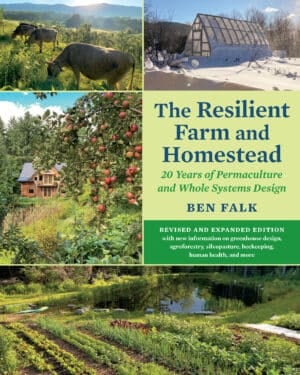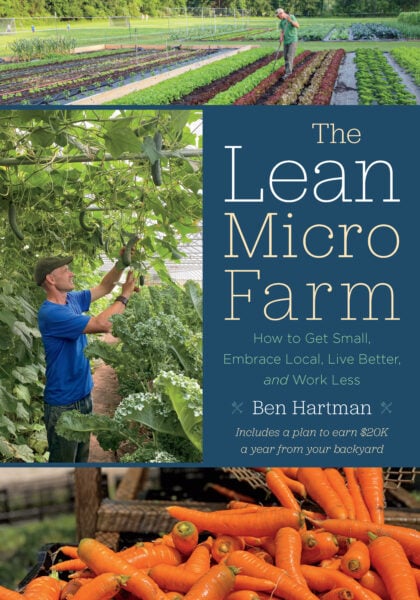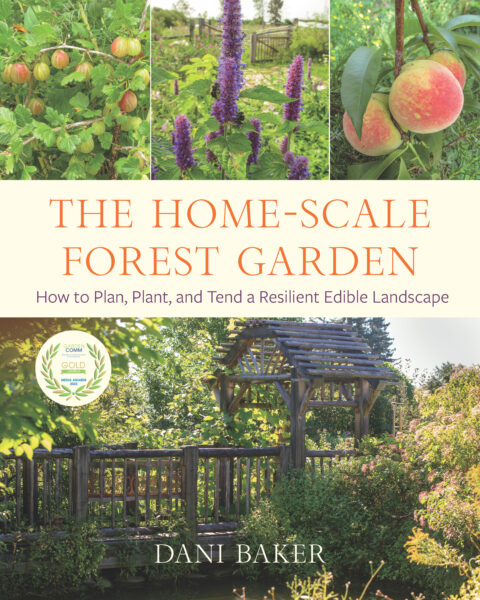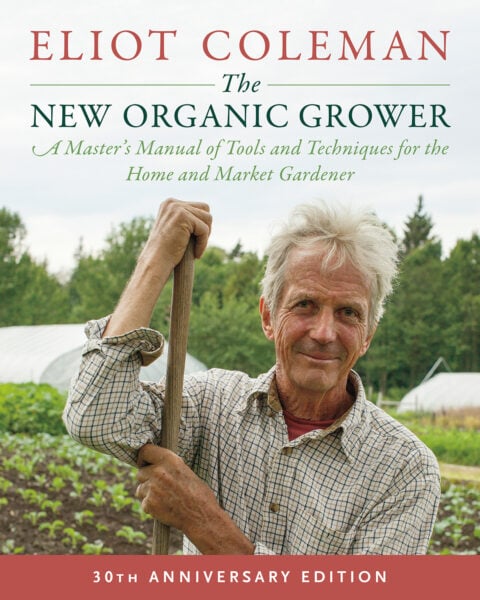Perennial Power: Why You Need Perennials in Your Garden
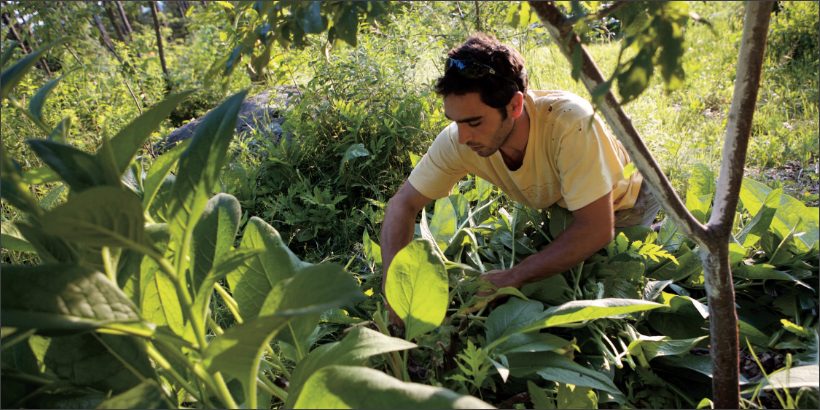
Keeping up with a garden can be a lot of work; luckily, there’s a secret weapon that will take away some of your stress. Perennials are the perfect addition to any garden, and only have to be planted once a decade!
The following is from The Resilient Farm and Homestead, Revised and Expanded Edition by Ben Falk. It has been adapted for the web.
(The author amid a guild of comfrey, wine cap mushrooms, clover, and dock under a canopy of plum at the homestead Photograph by Brian Mohr/EmberPhoto.)
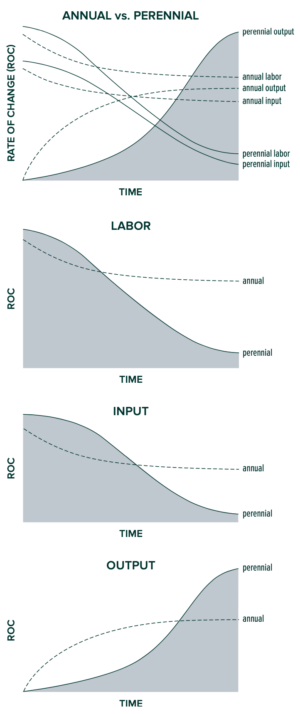
Annuals and perennials often entail inverse labor input and output relationships while perennial systems continually improve performance over time.
Growing Perennials
Perennial plants are growing to become the base load engines of our regenerative land system at the Whole Systems Research Farm.
These permanent producers only need to be established rarely—once every couple of decades to every century or three, depending on species—yet they can produce annually while building soil health and requiring little or no fertility inputs.
Because perennials are established only once a decade or century compared to annuals, which must be established once every year, they are able to put more energy into larger seed yields relative to annuals, which must spend a much higher proportion of their lifetime simply becoming established.
In addition, the roots of perennial plants inhabit deeper layers of the subsoil horizon with each passing year.
A landscape covered in mantle of perennial plants has the capacity to transform ever more subsoil (mineral soil) into topsoil (organic-matter-rich material) with each passing year.
A landscape of annual plants functions only to a very shallow layer—typically, the top six to eighteen inches of the earth’s surface, depending on soil quality, aridity, species, and other factors.
Many perennial plants penetrate two, three, six, twelve feet or even farther into the earth.
This rooting capacity brings organic matter, water, and biological activity—the basis for organic soil formation into the subsoil.
When we harness this mechanism, perennial plants allow us to farm more deeply the earth beneath our feet, thus doubling, tripling, or more the amount of mineral and other resources we are able to draw on in our job of growing value from the intersection of sun, soil, water, and living organisms.
Not surprisingly, perennial-based systems such as woodland/savannah system with three dimensions of crops, from grasses to shurbs to trees, and grazing in the understory typically captures between three and seven times the amount of solar energy as a field of annual crops.
Perennials and Drought Resistance
Their ability to grow deeply into the soil horizon allows perennials another advantage, which is often their most crucial advantage as the climate becomes more variable: drought resistance.
Deeper roots mean a much higher ability to mine deeper water tables and moisture that evaporates from the surface downward. Many arid areas of the world have been made more brittle and even created deserts because of a lack of adequate and appropriate perennial plants and disturbance mechanisms such as farming, which has often stocked the ecosystem with annuals.
In addition to drought resistance, perennials offer a high degree of flood resilience: They can often withstand seasonal inundation (if not exposed to high-flow velocities), whereas many annuals die or are rendered unusable (due to contamination) if they go underwater.
Equally important is perennials’ ability to grow tall above the ground, allowing us to farm additional vertical space into the atmosphere.
This vertical tendency offers a complementary value to the drought resistance achieved by their deep-rooting ability: Perennials actually harvest and increase the moisture available in a site and hold moisture in via shading.
The ability of perennials, most notably trees, to pull moisture out of humidity and to actually promote cloud formation over a landscape through evapotranspiration and structural texturing is why a forested area always receives more rainfall than the same landscape in the same region without forest. This is why humanity has made many deserts through deforestation.
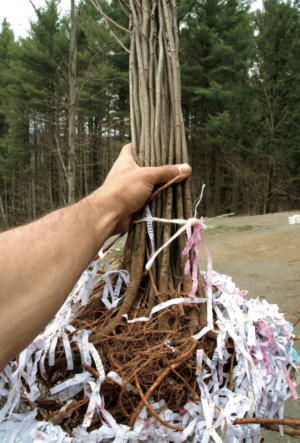
Fifty black locust seedlings—five to fifteen cords of fuelwood within about twenty years’ time. This tree offers by far the fastest return on investment in this climate when it comes to transforming sunshine into usable fuel. Photo courtesy of Ben Falk.
In much of the world, it can be clearly said that “losing our trees means losing our water.”
Losing trees, of course, also means losing the buffering effect on massive rainfalls and flooding as tree leaves reduce the erosive, percussive force of raindrops as they slow, spread, and sink surface water rather than promoting sheet flow off the landscape and, consequently, disastrous flooding.
Haiti is one of the best examples the world has to offer for deforestation begetting a wide range of ecological and social systems failure: With the disappearance of tree cover comes drought, flood, and massive soil loss.
With those catastrophes come social system dysfunction—the history of humans abusing land and ending up in a stricken society seems to bear this out repeatedly.
Perennials and Weather Conditions
Along with moisture-harvesting abilities are other microclimate-buffering capacities of a plant—or wall of plants—including the ability to reduce drying and stressful winds; slow and deposit snowfall, which is beneficial to tree, grass, and soil health; and serve as sun traps, increasing the radiant heat available in a landscape to promote ripening of a crop and offer season-extended outdoor use areas for people.
Related to the vertical ability of perennials is the sheer size and biomass potential of certain perennials.
You can’t turn any annual crop into fuel or structural material without lots of processing to combine thousands of smaller plants into something offering structural or energy yields.
Trees, on the other hand, offer such yield in their raw form—a woodland is a living lumberyard that needs minimal processing to be useful. A forest is also a direct source of fuel that can also be of value with little processing and energy expenditure. You simply can’t get such yields with an annual plant.
Finally, there is an increasingly important advantage to perennials that is just becoming better understood: Plants tend to accumulate toxins most acutely in their vegetative tissue, not in their seeds.
Most perennials offer us an edible yield of seeds, nuts, or fruit, which accumulate less toxic buildup of metals and inorganic chemicals.
This tendency also complements perennials’ tendency to more densely accumulate nutrients due in large part to their inhabiting a wider spectrum of the soil horizon and accessing a greater range of nutrients as a result, thus being able to make those nutrients available to people in the form of food.
Why Are Perennials Important?
To summarize, the reasons perennial crop plants are a crucial and foundational part of a cold-climate landscape are diverse and include the following:
- High return on investment (ROI) in energy, time, and materials, as they are only planted a few times per century. This stems from a generally high growth-to-establishment ratio. This allows more energy to go into yields (reproduction, seeds, fruit) and less, proportionally compared to an annual, into the organism’s establishing itself.
- Deep soil penetration: Allowing us to build more soil and access more nutrients and water.
- Climate resilience—drought and flood: A greater ability to both avoid and bounce back from climate stress, including heat, lack of water, and inundation.
- Microclimate enhancement: Moisture harvesting and holding, windbreak, snow fencing, sun traps.
- Structural yields: Timber, fencing, fuel.
- Human health enhancement: Toxicity avoidance and nutrient density—seeds and fruit tend to accumulate toxins less acutely than vegetative tissue, and perennials access a wider range of soil nutrients than annuals do.
Perennial Crop Disadvantages:
- Climate: Many yields from a perennial crop depend upon flower survival, which is becoming an ever greater challenge as global weirding produces early-season heat waves, often causing perennials to flower ahead of their normal period, damaging or destroying those flowers—and the fruit or nut crop they would yield (not to mention harming already stressed pollinators).
- Breeding cycles/genetic agility: Some annuals allow multiple seed-production cycles per season, which allows faster breeding of more adaptive strains of plants that can increase their fitness as the climate, pests, and atmospheric toxicity and other conditions shift.
- Slow yield: Annuals can give us a large yield from seed within months, not years or even decades of seeding. Perennials by nature require a longer lead time to get established and offer yields. The one-two perennial-annual punch of growing a lot of annuals while simultaneously planting perennials is key during site establishment.
- Space: Simply requiring more room in which to grow can be a downside for people living in urban or dense suburban spaces.
Recommended Reads
How to Grow Healthy Plants: Strengthening Your Farm or Garden’s Immune System
Recent Articles
With the right strategies and practices, composting on a small farm is surprisingly easy and inexpensive. Just follow these steps for making compost, and your farm will be thriving in no time! The following excerpt is from The Lean Farm Guide to Growing Vegetables by Ben Hartman. It has been adapted for the web. (All photographs by Ben…
Read MoreGarlic mustard: while known as “invasive,” this plant can be consumed in its entirety and has great nutritional value. Plus, the garlic-flavor is a perfect addition to any recipe that calls for mustard! The following are excerpts from Beyond the War on Invasive Species by Tao Orion and The Wild Wisdom of Weeds by Katrina…
Read MoreEveryone loves a refreshing, fermented, nutritious drink…even your garden! Take your fermentation skills out of the kitchen and into the garden by brewing fermented plant juice. The following is an excerpt from The Regenerative Grower’s Guide to Garden Amendments by Nigel Palmer. It has been adapted for the web. How to Make Fermented Plant Juice Fermented…
Read MoreWant to see your crops thrive this upcoming growing season? The key is in soil fertility and health. Spend time maintaining your soil’s health to guarantee bigger and better crops come harvest time! The following is an excerpt from No-Till Intensive Vegetable Culture by Bryan O’Hara. It has been adapted for the web. What Is Soil Fertility?…
Read MoreMany know the effects of catnip on our feline friends, but few realize that catnip has medicinal effects for humans. From stomach aches to reducing fevers, catnip is a versatile herb with many benefits. The next time you grow this plant for your cat you may end up taking a few cuttings for yourself! The…
Read More

